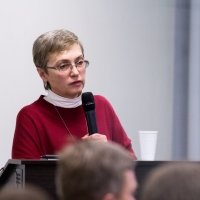"Angry Townspeople," the Internet, and the Market of Ideas: Vectors of Change in the Russian Public Sphere
“The transformation of the public sphere gave the Kremlin an opportunity to shape public opinion on the issues that were considered important,” argued Olga Malinova, Chief Research Fellow, at the Institute of Scientific Information for Social Sciences, Russian Academy of Sciences, and Professor, at the Moscow State Institute of International Relations, Moscow at a 23 April 2012 Kennan Institute lecture. Malinova analyzed the factors that influenced the unexpected rise of protest activity during the electoral campaigns of 2011 and 2012 in Russia, such as the rise of the middle class and reforms and regulation of mass media since the collapse of the Soviet Union.
The protests after the 2011 parliamentary election in Russia were “civic actions aimed to defend violated rights,” argued Malinova. One of the driving factors behind the protests was the steady rise of the Russian middle class. Malinova further explained that socioeconomic geography also played a role in the intensity of demonstrations, as the most mobilized demonstrations took place in large cities such as Moscow, where there is a notable concentration of the population earning higher incomes. In contrast, the population of provinces and small towns was easily mobilized for meetings and demonstrations in support of Putin, which were organized by the authorities.
What is remarkable about the recent protest campaign was that it was driven by political issues, not economic ones, according to the speaker. According to the Russian Public Opinion Research Center, readiness for participation in the protests increased from 23 percent in 2011 to 32 percent in 2012, whereas sociologists did not register a significant rise in protest attitudes during the economic crisis of 2007-2008.Ultimately, Malinova argued that the recent protest activity likely indicate important shifts in the patterns of mass political behavior.
According to Malinova, these shifts were prompted not only by social changes, but also by recent developments in the structures of political communication channels. The Russian mass media outlets still maintain a presence in shaping political discourse in Russia today. However, political reforms of the 1990s transformed the structure of public communications, which created an imbalance in what kind of information was accessible. The speaker explained that central television stations and few nation-wide periodicals represented the “core” perspectives of the public sphere, while local radio, TV, and press represented the “periphery” perspectives. However, the political domination of the core was sufficient enough to influence public opinion.
The authorities largely failed to take control of the public agenda during the 1990s; however, the situation changed with Vladimir Putin’s accession to power. Some of his administration’s main policies on media regulation included the closing of independent television channels, as well as limiting the press’s access to information. Although pluralism was not legally prohibited as a result of these policies, the presence of “periphery” perspectives on political issues declined while the “core” perspective remained relatively stable. During the 2011-2012 election season, United Russia used that unbalanced media environment to promote Vladimir Putin—and the party’s agenda overall—in the public sphere.
Notwithstanding the limited information disseminated through traditional media outlets, Malinova credited the internet as a tool central to mobilizing the recent protests. Statistics indicate a growing number of internet users in Russia, who are based in major cities as well as lesser-populated regions.Although new media such as the internet promote interconnectedness and the exchange of information, the speaker argued that is still difficult to reach a general consensus in such a diverse country. Basing on the classification of Natalia Zubarevich, Malinova indicated that four different socio-geographic segments divide Russia today: a postindustrial megalopolis comprising approximately 21 percent of the population; small, industrial cities with inherited Soviet economy that include 25 percent of the population; the enormous periphery of small villages containing 38 percent of the population; and the ethnic republics of the North Caucasus and South Siberia, where 6 percent of the population reside.
In conclusion, Malinova argued that Russia is geographically, economically, and socially diverse, and is undergoing a complex political transformation as the country transitions from the post-Soviet era. Despite the existing pluralism in the public sphere, core political perspectives and agendas are nonetheless still propagated through the central system of information.
By Elena Volkava
Blair Ruble, Director, Kennan Institute
The Kennan Institute speaker series is made possible through the generous support of the Title VIII Program of the U.S. Department of State.
Speaker

Chief Research Fellow, Institute of Scientific Information for Social Sciences, Russian Academy of Sciences, and Professor, Higher School of Economics
Hosted By

Kennan Institute
The Kennan Institute is the premier US center for advanced research on Eurasia and the oldest and largest regional program at the Woodrow Wilson International Center for Scholars. The Kennan Institute is committed to improving American understanding of Russia, Ukraine, Central Asia, the South Caucasus, and the surrounding region though research and exchange. Read more
